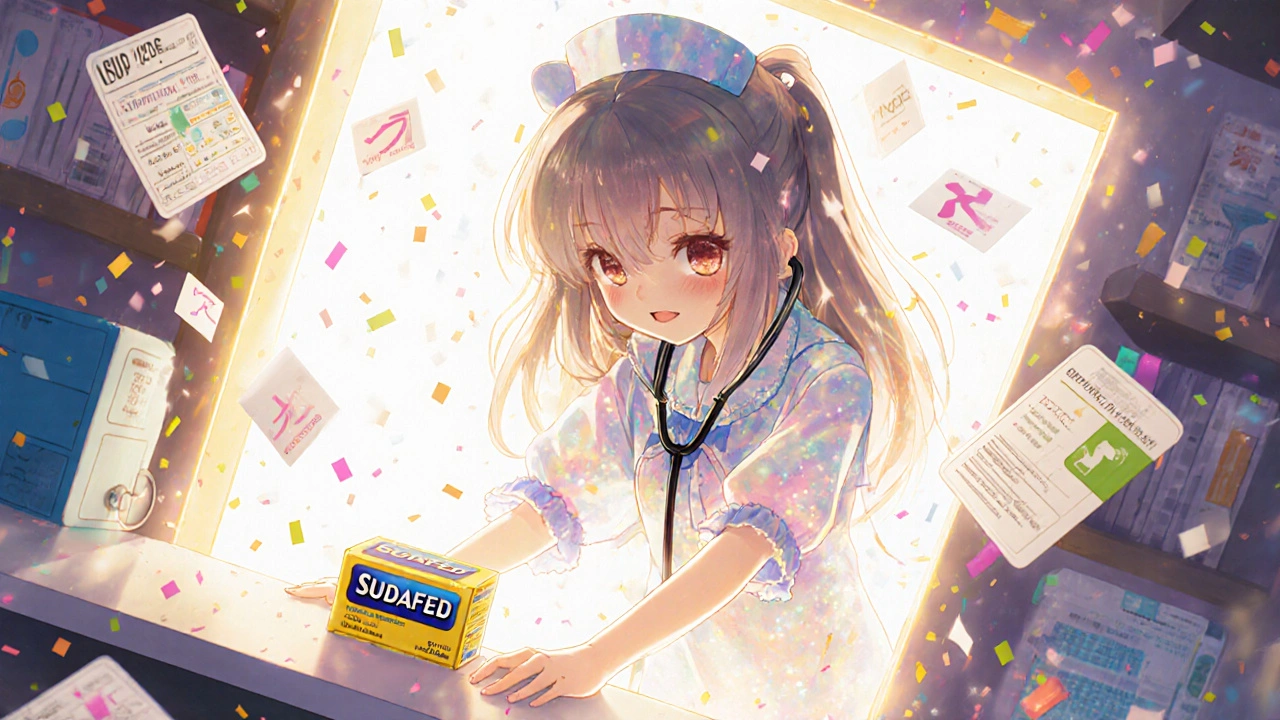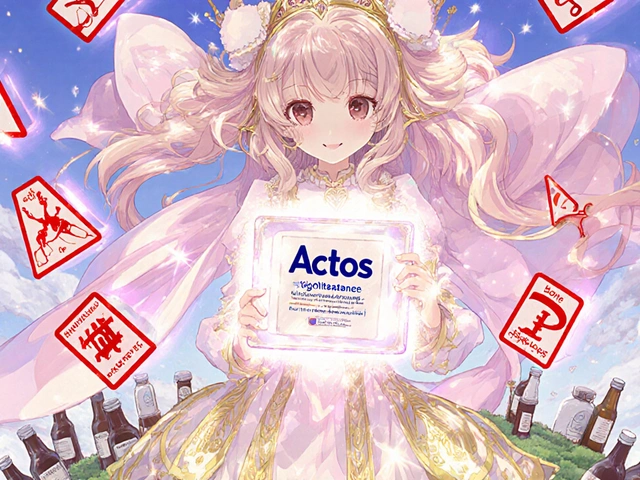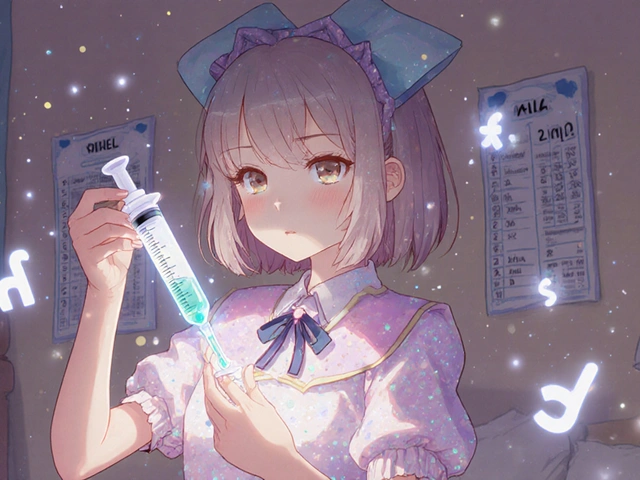Ever stood in front of the pharmacy counter, holding a box of Sudafed, waiting for the pharmacist to unlock it? You’re not alone. Millions of Americans face this same moment every year-not because they need a prescription, but because the medicine they’re trying to buy is behind-the-counter. These aren’t prescription drugs. They’re not on the shelf like aspirin or allergy pills. They’re locked up, and you have to talk to someone before you can get them. Why? And what else is hidden behind those counters?
What Exactly Is Behind-the-Counter?
Behind-the-counter (BTC) medications sit in a gray zone between regular over-the-counter (OTC) drugs and prescription-only medicines. You don’t need a doctor’s note. But you can’t just grab them off the shelf. You have to ask a pharmacist. They’ll check your ID, log your purchase, and ask you a few questions. This system started in 2006 after Congress passed the Combat Methamphetamine Epidemic Act. The goal? Stop people from using pseudoephedrine-a common cold medicine ingredient-to make illegal meth. It worked. But it also created a new kind of pharmacy rule that’s still growing today.Common Behind-the-Counter Medications
You won’t find these on the shelf, even if you’re shopping at Walmart or CVS. Here are the most common ones:- Pseudoephedrine (Sudafed, Claritin-D, Allegra-D): The original BTC drug. Each tablet has 30-60 mg. You can buy up to 3.6 grams per day and 9 grams per month. Every purchase is tracked in a national database called NPLEx. You need a photo ID. No exceptions.
- Emergency contraception (Plan B One-Step, Next Choice): Available without a prescription if you’re 17 or older. You still need to ask the pharmacist. Some stores require you to go to the counter. Others have a special cabinet with a lock. The pill is 89% effective if taken within 72 hours.
- Insulin (Walmart’s ReliOn): Regular insulin and NPH insulin are sold behind the counter for $25-$40 per vial. No prescription needed. This is a big deal for people without insurance. Newer insulins like NovoLog still require a prescription.
- Codeine cough syrup (in some states): A few states still allow low-dose codeine cough syrup behind the counter. Most others require a prescription now.
These aren’t random choices. They’re drugs with real risks-but also real benefits. Pseudoephedrine works better than phenylephrine (the OTC alternative) for nasal congestion. Studies show it’s 72% effective versus phenylephrine’s 38%. But because it can be misused, it’s locked up. Emergency contraceptives are fast-acting and life-changing for many, but regulators worry about underage access. So they put the pharmacist between you and the medicine.
Why the Restrictions? The Real Reasons
The rules aren’t just about stopping meth production. They’re about managing risk. Pseudoephedrine isn’t dangerous if you use it as directed. But if someone buys 10 packs a week, that’s a red flag. The tracking system helps law enforcement spot patterns. It’s not perfect. Illicit drug makers have moved to other chemicals. But the system still blocks thousands of attempts each year.For emergency contraceptives, the goal was to increase access without making it too easy. Before 2013, you needed a prescription. That meant delays, missed windows, and higher costs. Now, you can walk in at midnight and get it. But the pharmacist still checks your age. That’s meant to protect minors while keeping the door open for adults.
Insulin is different. Here, the issue isn’t abuse-it’s affordability. People with diabetes can’t always afford $300 vials. Walmart’s ReliOn insulin changed that. By making it available without a prescription, they cut out the middleman. No doctor visit. No insurance paperwork. Just walk in, show ID, pay $25, and go.

What You Need to Know Before You Buy
Buying BTC meds isn’t like grabbing a box of Tylenol. Here’s what actually happens when you go to the counter:- You hand over your government-issued photo ID. Driver’s license, state ID, passport-anything official.
- The pharmacist scans your ID and logs your purchase into NPLEx (in 45 states). This database tracks how much you’ve bought in the last 30 days.
- You’ll be asked if you’re buying for yourself. Sometimes they ask why you need it.
- You’ll get a printed receipt showing what you bought, the date, and your ID number.
- You pay. No discounts apply to BTC purchases in most cases.
It takes 5-7 minutes. That’s longer than grabbing a bandage. But it’s not a medical exam. You don’t need to answer personal questions unless they’re relevant to safety. For example, if you’re buying insulin and you say you’re diabetic, they might ask if you know how to use it. That’s helpful advice-not an interrogation.
Problems with the System
The BTC model sounds fair. But in practice, it’s messy.State rules vary wildly. Oregon lets you buy 7.5 grams of pseudoephedrine a month. Texas allows 9 grams. Some states have no limits at all. If you travel, you might get turned away because you hit your limit in another state. The database is national, but the rules aren’t.
Pharmacists sometimes say no. A 2022 study found 18% of people trying to buy Plan B were refused or delayed-even though it’s legal. Some pharmacists have moral objections. Others just get busy and forget to process it. In rural areas, where there’s only one pharmacy, that delay can cost you.
Racial bias exists. A University of Michigan study found Black customers were 3.2 times more likely to be questioned or refused when buying pseudoephedrine-even when their buying patterns matched white customers exactly. That’s not about policy. That’s about human bias.
It’s inconvenient. If you’re sick and need Sudafed at 10 p.m., you can’t just run to the gas station. You need to find a pharmacy that’s open. In rural America, 60 million people live more than 10 miles from a pharmacy. For them, BTC means no access.

What’s Next for Behind-the-Counter Medications?
The FDA is already thinking bigger. In May 2023, they approved the first BTC opioid treatment drug: LoRez (low-dose naltrexone) for alcohol use disorder. That’s a big step. It means the system isn’t just for cold medicine anymore. It’s becoming a tool to expand access to important treatments without requiring a doctor’s visit.Analysts predict 5-7 more prescription drugs will move to BTC status by 2027. Top candidates include:
- Low-dose atorvastatin (for cholesterol)
- 150mg mifepristone (for certain reproductive conditions)
- Higher-dose antihistamines (for severe allergies)
Why? Because pharmacists are trained to spot misuse, give advice, and catch dangerous interactions. They’re more accessible than doctors. And for many people, especially in underserved areas, that’s the only way they’ll get care.
But there’s a catch. Right now, there are 28 different state laws governing BTC sales. That’s chaos for pharmacies. A chain like CVS has to train staff differently in every state. It’s expensive. The National Conference of State Legislatures says it’s a nightmare for compliance. Experts warn that without federal standards, the BTC system could become a patchwork of rules that hurts more than it helps.
What This Means for You
If you need a BTC medication:- Always bring your ID. No ID, no purchase.
- Know your limits. Track your purchases if you buy frequently.
- Ask questions. Pharmacists are there to help. Don’t be afraid to say, “I’m not sure how to use this.”
- If you’re refused without reason, ask to speak to the manager. It might be a policy error.
- For insulin or emergency contraception, consider calling ahead. Some stores keep stock in the back and may need time to retrieve it.
If you’re frustrated by the system-you’re not alone. But remember: these rules were made to protect people. The problem isn’t the concept. It’s the uneven way they’re applied.
Should More Drugs Go Behind the Counter?
Most pharmacists say yes. A 2023 Pharmacy Times survey found 73% support expanding BTC status. Why? Because they see the value. A pharmacist can spot if you’re taking too many painkillers. They can warn you about mixing alcohol with antihistamines. They can help you choose between two similar products.But doctors and researchers are split. Dr. Aaron Kesselheim from Harvard says pseudoephedrine restrictions haven’t stopped meth production-they’ve just pushed it elsewhere. Dr. John Santa from Consumer Reports says BTC is the right balance for drugs that are useful but risky.
The truth? It’s not about locking things up. It’s about making sure the right people get the right care at the right time. For some, BTC means access. For others, it means delay. The goal should be to fix the gaps-not remove the system.
Can I buy pseudoephedrine without an ID?
No. Federal law requires a government-issued photo ID for every pseudoephedrine purchase. This applies to all pharmacies, even if they’re in a state with looser rules. No ID means no sale.
Why is Plan B behind the counter if it’s OTC?
Plan B is technically OTC, but it’s kept behind the counter to verify age. If you’re under 17, you can’t buy it without a prescription. Keeping it locked prevents underage access while still letting adults get it quickly without a doctor’s visit.
Can I buy insulin without a prescription anywhere?
Only certain types of insulin are available without a prescription-and only at specific retailers. Walmart’s ReliOn brand (regular and NPH insulin) is the most common. Other pharmacies may require a prescription, even for generic insulin. Always check before you go.
Do all states have the same BTC rules?
No. Each state sets its own rules for purchase limits, age requirements, and tracking systems. For example, Oregon limits pseudoephedrine to 7.5 grams per month. Texas allows 9 grams. Some states don’t track purchases at all. This creates confusion for travelers and pharmacies.
Can a pharmacist refuse to sell me Plan B?
Legally, no-if you’re 17 or older and meet the requirements. But some pharmacists still refuse based on personal beliefs. If this happens, ask to speak to the manager or go to another pharmacy. Many states have laws requiring pharmacies to refer you to another provider if they won’t fill the order.
Are BTC medications more expensive than regular OTC?
Usually not. The price is the same as the OTC version. But you can’t use coupons or discount cards for BTC purchases in most cases because they’re tracked and regulated. Generic versions like store-brand pseudoephedrine are often cheaper than name brands like Sudafed.
Why can’t I buy pseudoephedrine online?
Federal law bans online sales of pseudoephedrine because it can’t be verified that the buyer is who they say they are. Even if a website claims to sell it, it’s illegal. Only in-person purchases with ID are allowed.






Comments
Latrisha M.
November 16, 2025 AT 09:39 AMJust want to say: if you’re buying pseudoephedrine, always bring your ID. No exceptions. Pharmacists aren’t being difficult-they’re following federal law. And if you’re diabetic and need ReliOn insulin? Thank God for Walmart. $25 is a lifeline.
Deepak Mishra
November 16, 2025 AT 11:49 AMOMG I JUST GOT DENIED PLAN B BECAUSE THE PHARMACIST WAS ON HIS PHONE 😭 I WAS CRYING IN THE PARKING LOT LIKE A DRAMA QUEEN!!! 😭💔 #PharmacyTrauma
Diane Tomaszewski
November 18, 2025 AT 05:13 AMI get why this system exists but it’s weird how something so simple turns into a whole ordeal. People just want to feel better or stay healthy. Why does it have to be so complicated?
Rachel Wusowicz
November 18, 2025 AT 06:47 AMThey say it’s to stop meth… but what if it’s really about control? Who tracks all that data? Who’s watching your purchases? NPLEx isn’t just a database-it’s a surveillance tool disguised as public safety. And don’t get me started on the insulin thing… why is Walmart the only one doing this? Is Big Pharma scared of affordability? I think so… I think they’re scared…
Oyejobi Olufemi
November 20, 2025 AT 00:39 AMOf course you can’t buy pseudoephedrine online-because the government doesn’t trust YOU! They think you’re a meth cook waiting to happen! And yet, they let anyone walk into a pharmacy with a fake ID and buy 30 packs! The system is BROKEN! You think they care about your diabetes? No! They care about liability! And Plan B? They lock it up because they don’t want teens having sex! It’s all about morality, not science!
David Rooksby
November 21, 2025 AT 21:54 PMLook, I’m British and I’ve seen this kind of thing before with codeine cough syrup-used to be OTC here too, then suddenly you needed a script. The truth? It’s not about meth. It’s about liability. Pharmacies don’t want to be sued. So they over-comply. They make you jump through hoops because it’s easier than dealing with one angry customer who got caught buying too much Sudafed. It’s not about you-it’s about them covering their backs. And now they’re doing it with insulin? That’s just… sad. People are dying because they can’t afford insulin, and the solution is… more bureaucracy? Brilliant.
Jamie Watts
November 23, 2025 AT 07:44 AMStop acting like this is some big conspiracy. You want Sudafed? Show ID. You want Plan B? Show ID. You want insulin? Show ID. It’s not that hard. And if you’re getting judged for buying it? That’s on you for acting shady. I’ve bought Plan B at midnight after a bad date and the pharmacist gave me a hug. It’s not about suspicion-it’s about care. Stop being dramatic.
Daniel Stewart
November 23, 2025 AT 10:57 AMThere’s a deeper metaphysical layer here, isn’t there? The pharmacy counter is a modern altar-a place where medicine, authority, and personal autonomy collide. We hand over our identity documents like sacred relics, and in return, we are granted access to the elixir of health. But at what cost? The pharmacist becomes priest, the database becomes oracle, and we, the supplicants, kneel before the altar of bureaucratic compassion. Is this liberation-or the quiet surrender of bodily sovereignty?
Teresa Smith
November 23, 2025 AT 14:35 PMAs a nurse practitioner, I see the real impact of these restrictions every day. The system isn’t perfect, but it works better than nothing. The real problem is the lack of standardization. Why does Oregon allow 7.5 grams and Texas 9? That’s not public health-that’s administrative chaos. We need federal guidelines. Until then, pharmacists are stuck between law and humanity. Let’s fix the system, not blame the people trying to follow it.
Melanie Taylor
November 25, 2025 AT 05:14 AMJust had to buy Plan B in rural Georgia last month… the pharmacist was so sweet, gave me a free tea and told me to call if I needed anything. 🥺❤️ It’s not just about the pill-it’s about being seen. Pharmacies are the last real community health hubs. Let’s protect them, not complain about the ID check.
John Mwalwala
November 26, 2025 AT 09:40 AMLet’s be real-this is all part of the pharmaceutical-industrial complex’s master plan. Pseudoephedrine is cheaper than phenylephrine, so Big Pharma lobbied to remove it from shelves so you’d buy their overpriced alternatives. NPLEx? That’s a data mining operation. Your purchase history is sold to insurers, advertisers, even employers. And insulin? Walmart’s ReliOn is a Trojan horse-they’re using it to lure customers in so they can upsell you on $300 generics later. This isn’t public health. It’s corporate strategy disguised as compassion.
Dan Angles
November 27, 2025 AT 13:07 PMWhile the current regulatory framework presents logistical challenges, particularly in the context of interstate variability and compliance burdens, it remains a necessary mechanism for mitigating public health risks associated with the diversion of controlled substances. The integration of pharmacist oversight into the distribution of certain medications reflects an evidence-based approach to harm reduction. Standardization across jurisdictions is indeed warranted, but the foundational principle-that pharmacists serve as accessible, trained gatekeepers in the medication access continuum-remains both valid and commendable. Further expansion to other therapeutic classes, including statins and antihistamines, should be pursued with rigorous clinical and ethical evaluation.